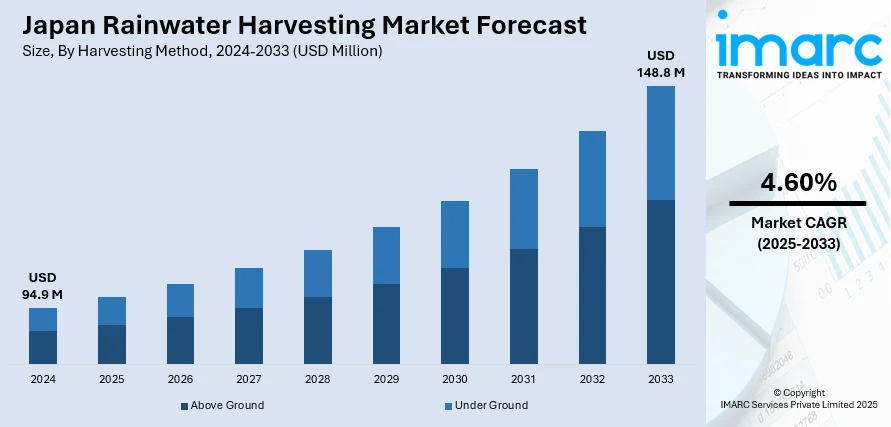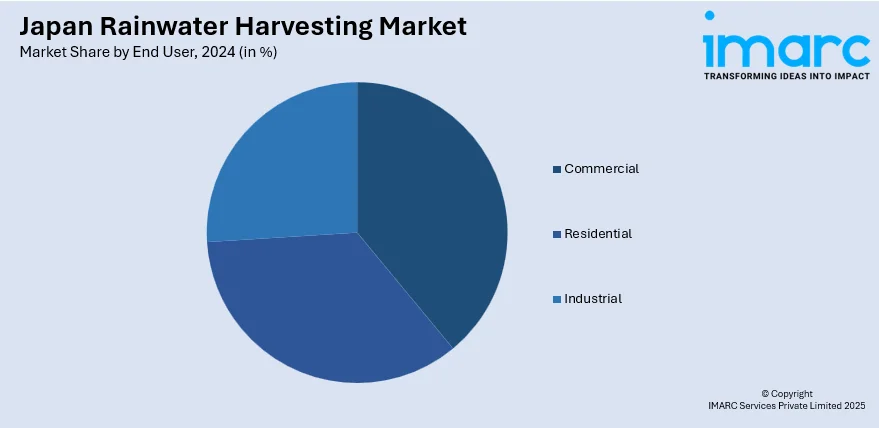
Japan Rainwater Harvesting Market Size, Share, Trends and Forecast by Harvesting Method, End User, and Region, 2025-2033
Japan Rainwater Harvesting Market Overview:
The Japan rainwater harvesting market size reached USD 94.9 Million in 2024. Looking forward, IMARC Group expects the market to reach USD 148.8 Million by 2033, exhibiting a growth rate (CAGR) of 4.60% during 2025-2033. The market is spurred by the increasing demand for water conservation during climate change and regular droughts, government support of sustainable behavior, urbanization, and finite freshwater resources. Further, innovation in rainwater harvesting and purification equipment makes it more viable for household and business consumption.
|
Report Attribute
|
Key Statistics
|
|---|---|
|
Base Year
|
2024
|
|
Forecast Years
|
2025-2033
|
|
Historical Years
|
2019-2024
|
| Market Size in 2024 | USD 94.9 Million |
| Market Forecast in 2033 | USD 148.8 Million |
| Market Growth Rate 2025-2033 | 4.60% |
Japan Rainwater Harvesting Market Trends:
Integration of Smart Technologies
Smart technology integration into rainwater harvesting systems is a significant trend influencing the Japan rainwater harvesting market outlook. With improvements in IoT (Internet of Things) and sensor technology, rainwater harvesting systems are becoming automated and more efficient. Smart meters and sensors aid in tracking water levels, leak detection, and optimal utilization of harvested water, making it more efficient and saving on waste. Besides this, systems are also being constructed to switch between harvested rainwater and municipal water automatically, depending on availability, to provide a consistent and sure water supply. This is also in line with Japan's robust emphasis on technological innovation and progress, especially within urban regions where water conservation and effective resource use are essential. With consumers increasingly seeking convenient and sustainable solutions, demand for smart rainwater harvesting systems is likely to increase, thus making the technology a key component of contemporary water management solutions for residential and commercial properties.

Urbanization and Residential Adoption
The rapid urbanization rate of the country is propelling the Japan rainwater harvesting market growth, especially in residential areas. With increasing city population, there is a greater need for clean water sources. Consequently, residential homes and apartment buildings are shifting to rainwater harvesting as an alternative water source for non-drinking purposes like gardening, flushing toilets, and washing. As urban communities experience water scarcity and expensive water, rainwater harvesting is a practical solution for decreasing reliance on municipal water supplies. Incentives provided by the government and public awareness programs also stimulate residential take-up, making the systems affordable for homeowners. Moreover, environmentally aware consumers increasingly seek means of decreasing their ecological impact, which triggers demand for rainwater harvesting solutions. As urban growth persists, residential rainwater harvesting will be on the rise, with homes and buildings investing in systems for collecting and utilizing rainwater effectively.
Commercial and Industrial Applications
The Japan rainwater harvesting market share is expanding its reach beyond residential settings into the commercial and industrial sectors. Large-scale buildings, factories, and shopping malls are increasingly adopting rainwater harvesting as part of their sustainability initiatives. These sectors face high water consumption, which drives the need for alternative sources to reduce costs and environmental impact. By capturing and storing rainwater, businesses can use the resource for non-potable purposes like landscaping, cooling systems, and cleaning, lowering overall water usage and utility costs. Furthermore, many corporations are incorporating rainwater harvesting as part of their corporate social responsibility (CSR) strategies to demonstrate environmental stewardship and commitment to sustainable practices. Government regulations and incentives also support the installation of rainwater harvesting systems in commercial buildings, making it more financially feasible for companies. As sustainability becomes a priority for both businesses and consumers, the trend of rainwater harvesting in commercial and industrial applications is likely to continue growing.
Japan Rainwater Harvesting Market Segmentation:
IMARC Group provides an analysis of the key trends in each segment of the market, along with forecasts at the regional level for 2025-2033. Our report has categorized the market based on harvesting method and end user.
Harvesting Method Insights:
- Above Ground
- Under Ground
The report has provided a detailed breakup and analysis of the market based on the harvesting method. This includes above ground and under ground.
End User Insights:

- Commercial
- Residential
- Industrial
The report has provided a detailed breakup and analysis of the market based on the end user. This includes commercial, residential, and industrial.
Regional Insights:
- Kanto Region
- Kansai/Kinki Region
- Central /Chubu Region
- Kyushu-Okinawa Region
- Tohoku Region
- Chugoku Region
- Hokkaido Region
- Shikoku Region
The report has also provided a comprehensive analysis of all the major regional markets, which include Kanto Region, Kansai/Kinki Region, Central /Chubu Region, Kyushu-Okinawa Region, Tohoku Region, Chugoku Region, Hokkaido Region, and Shikoku Region.
Competitive Landscape:
The market research report has also provided a comprehensive analysis of the competitive landscape. Competitive analysis such as market structure, key player positioning, top winning strategies, competitive dashboard, and company evaluation quadrant has been covered in the report. Also, detailed profiles of all major companies have been provided.
Japan Rainwater Harvesting Market News:
- In February 2025, a collaborative effort was initiated to create sustainable water systems, improve disaster readiness, and tackle the urgent requirement for water security and safe hygiene measures in the Federated States of Micronesia (FSM) and the Republic of the Marshall Islands (RMI). The two-year water, sanitation, and hygiene (WASH) initiative, financed by Japan, will be carried out by the International Organization for Migration (IOM) and the United Nations Children’s Fund (UNICEF) alongside the Governments of the FSM and the RMI. This initiative will establish new rainwater harvesting systems and rehabilitate existing water catchments and groundwater wells to ensure sustainable water sources for community members.
Japan Rainwater Harvesting Market Report Coverage:
| Report Features | Details |
|---|---|
| Base Year of the Analysis | 2024 |
| Historical Period | 2019-2024 |
| Forecast Period | 2025-2033 |
| Units | Million USD |
| Scope of the Report |
Exploration of Historical Trends and Market Outlook, Industry Catalysts and Challenges, Segment-Wise Historical and Future Market Assessment:
|
| Harvesting Methods Covered | Above Ground, Under Ground |
| End Users Covered | Commercial, Residential, Industrial |
| Regions Covered | Kanto Region, Kansai/Kinki Region, Central /Chubu Region, Kyushu-Okinawa Region, Tohoku Region, Chugoku Region, Hokkaido Region, Shikoku Region |
| Customization Scope | 10% Free Customization |
| Post-Sale Analyst Support | 10-12 Weeks |
| Delivery Format | PDF and Excel through Email (We can also provide the editable version of the report in PPT/Word format on special request) |
Key Questions Answered in This Report:
- How has the Japan rainwater harvesting market performed so far and how will it perform in the coming years?
- What is the breakup of the Japan rainwater harvesting market on the basis of harvesting method?
- What is the breakup of the Japan rainwater harvesting market on the basis of end user?
- What is the breakup of the Japan rainwater harvesting market on the basis of region?
- What are the various stages in the value chain of the Japan rainwater harvesting market?
- What are the key driving factors and challenges in the Japan rainwater harvesting?
- What is the structure of the Japan rainwater harvesting market and who are the key players?
- What is the degree of competition in the Japan rainwater harvesting market?
Key Benefits for Stakeholders:
- IMARC’s industry report offers a comprehensive quantitative analysis of various market segments, historical and current market trends, market forecasts, and dynamics of the Japan rainwater harvesting market from 2019-2033.
- The research report provides the latest information on the market drivers, challenges, and opportunities in the Japan rainwater harvesting market.
- Porter's five forces analysis assist stakeholders in assessing the impact of new entrants, competitive rivalry, supplier power, buyer power, and the threat of substitution. It helps stakeholders to analyze the level of competition within the Japan rainwater harvesting industry and its attractiveness.
- Competitive landscape allows stakeholders to understand their competitive environment and provides an insight into the current positions of key players in the market.
Need more help?
- Speak to our experienced analysts for insights on the current market scenarios.
- Include additional segments and countries to customize the report as per your requirement.
- Gain an unparalleled competitive advantage in your domain by understanding how to utilize the report and positively impacting your operations and revenue.
- For further assistance, please connect with our analysts.
 Request Customization
Request Customization
 Speak to an Analyst
Speak to an Analyst
 Request Brochure
Request Brochure
 Inquire Before Buying
Inquire Before Buying




.webp)




.webp)












